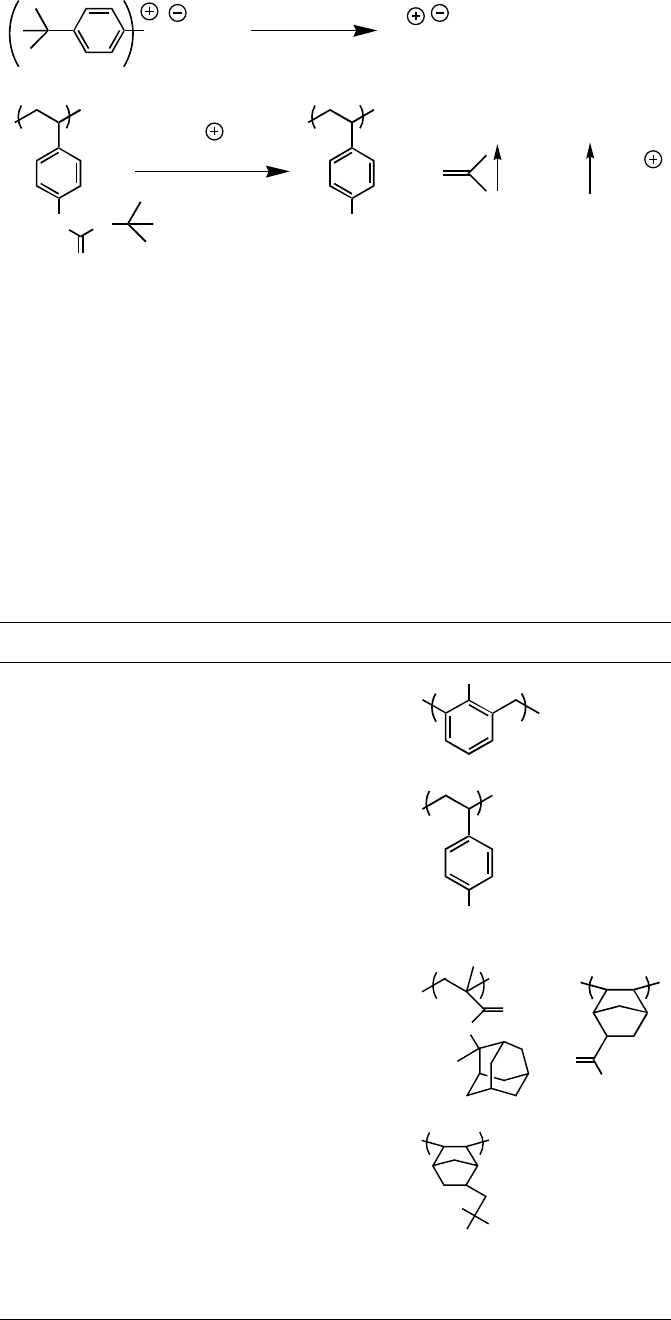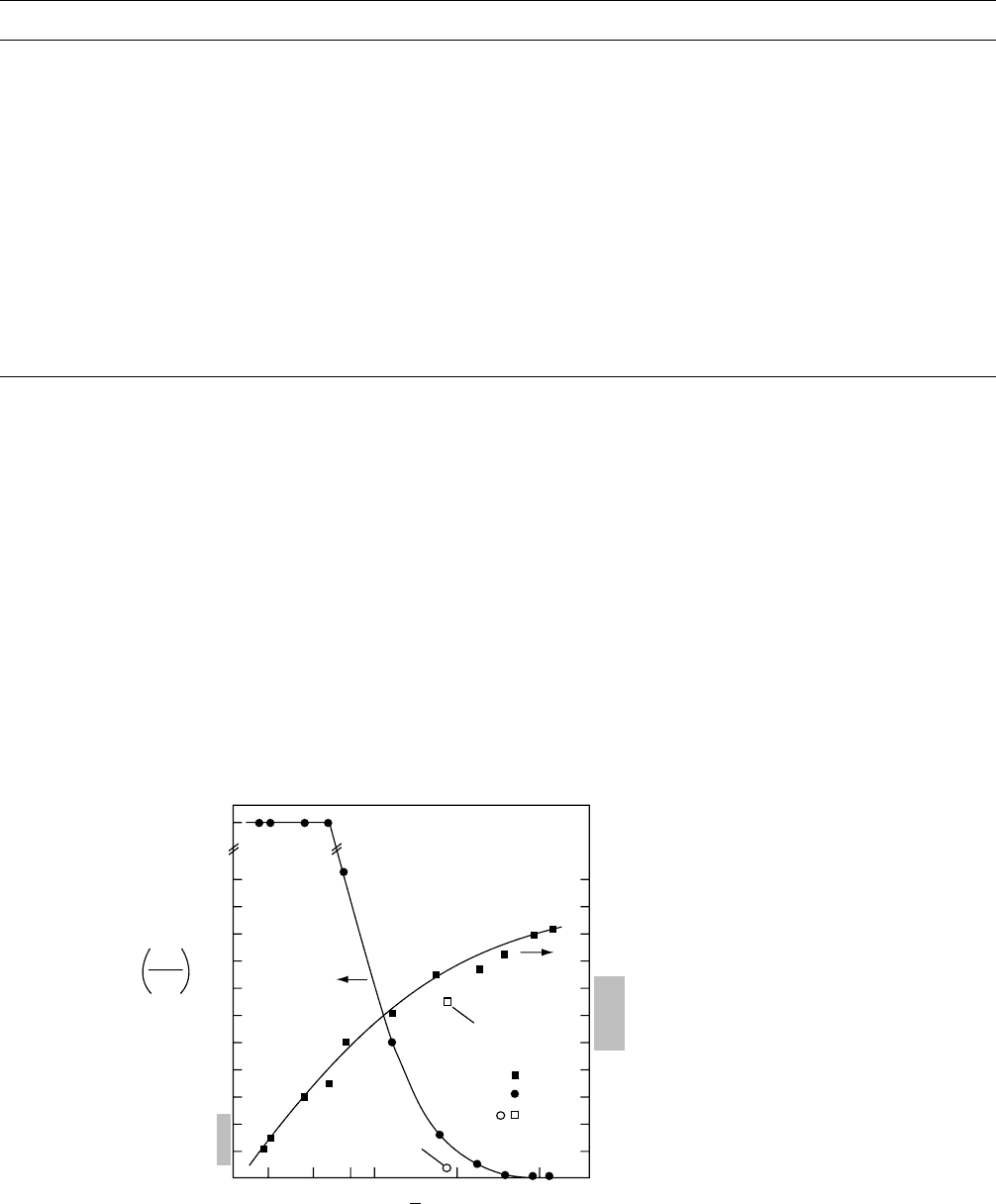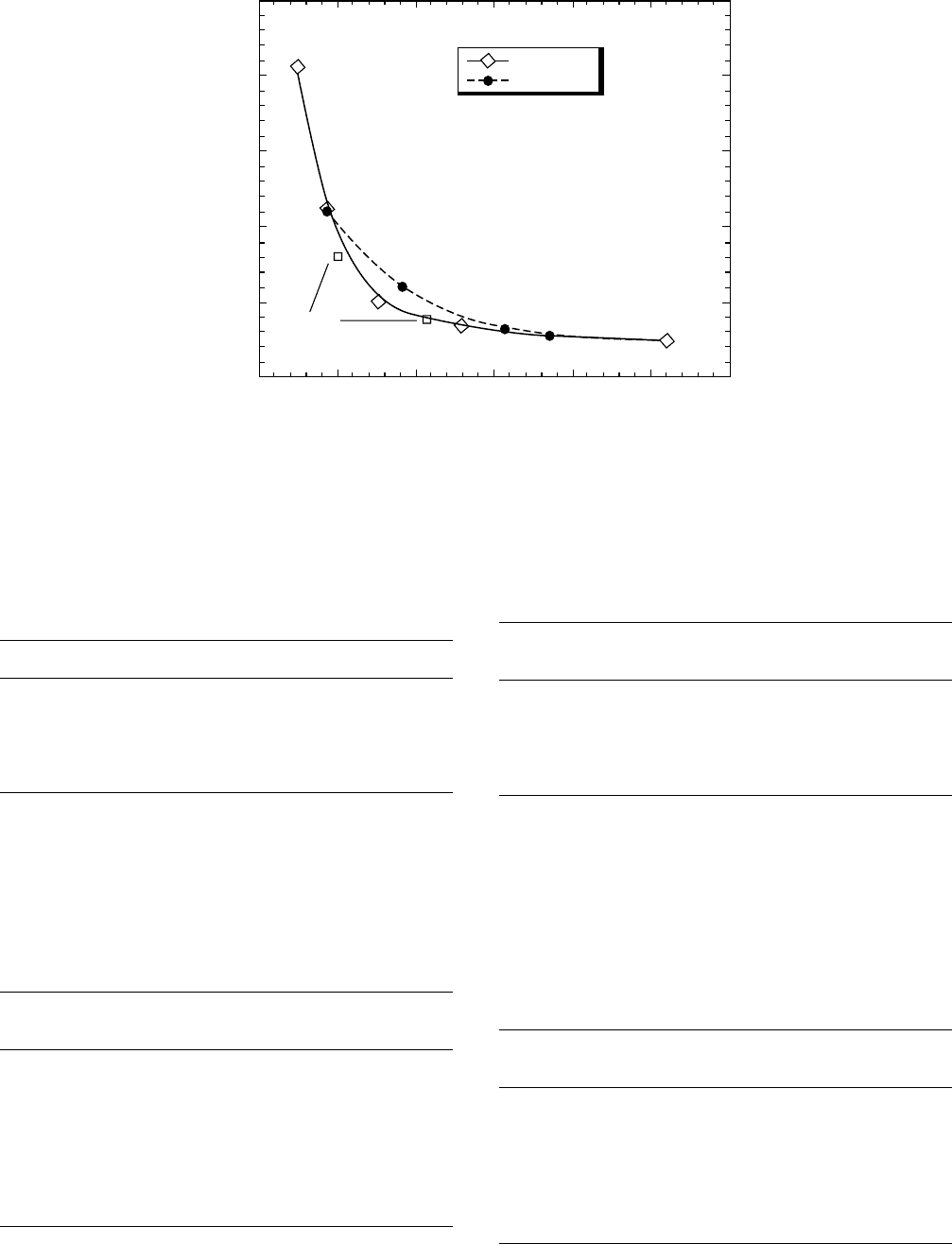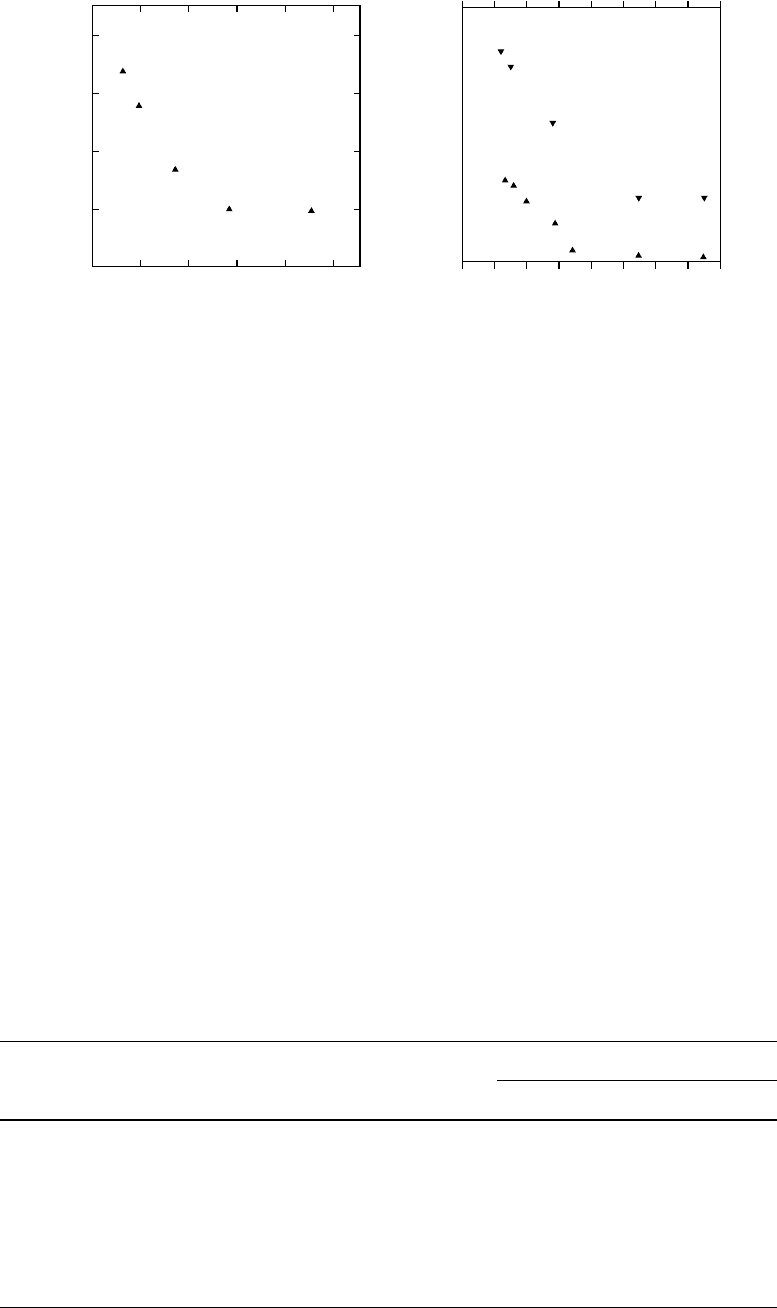Mark James E. (ed.). Physical Properties of Polymers Handbook
Подождите немного. Документ загружается.


57.3 OPTICAL PROPERTIES OF LITHOGRAPHIC
POLYMERS AND PHOTORESISTS
Polymers for photoresists must meet stringent transpar-
ency requirements at the imaging wavelength in order to
deliver superior resolution and image quality. Suitable poly-
mer platforms have been identified for I-line (365 nm) and
248 nm DUV lithography. They are meta-cresol novolak
and poly(4-hydroxystyrene), respectively. Novolak and
poly(4-hydroxystyrene), however, are not suitable for
193 nm single layer lithography because of their high ab-
sorption at 193 nm wavelength as a result of the p--- p
transition of the double bonds in these polymers.
The transparency requirements, along with plasma etch
resistant requirements, have led to a strategy for design-
ing new polymers for 193 nm lithography, namely, the
TABLE 57.1. Major polymer platforms for the evolving exposure technologies.
Technology node Exposure technology Polymer platform
0:8---0:35mm I-Line (365 nm)
OH
n
0:25---0:15mm DUV (248 nm)
OH
n
130–65 nm DUV (193 nm)
n
OH
O
O
O
45–32 nm DUV (157 nm)
HO
F
3
C
CF
3
# 25 nm EUV (13 nm) ?
O
H
O
O
OH
+
n
+
H
CO
2
n
+
I
SO
3
CF
3
SO
3
CF
3
+
other products
hn
2
H
SCHEME 57.1. Chemical amplification in a positive-tone photoresist.
PROPERTIES OF PHOTORESIST POLYMERS / 967

incorporation of saturated aliphatic rings to form cycloali-
phatic polymers. These saturated aliphatic rings can be
incorporated into the polymer side chain [11–14] or in the
polymer main chain [15,16], or a combination of both. Some
of the most popular alicylic 193 nm photoresist polymers
are depicted below:
The absorption of organic polymers at 157 nm is domin-
ated by the C (2p) electrons. An early audition of a large
number of both organic and inorganic polymers indicated
that fluorinated hydrocarbon polymers and siloxane poly-
mers were the most promising polymer platforms to achieve
adequate transparency and plasma etch resistance [17]. This
pioneering work has spurred tremendous efforts to develop
transparent and etch resistant fluoropolymers for 157 nm
lithography.
Tables 57.2–57.4 list the optical constants of some poly-
mers at 157 nm. In these tables, M
w
and T
g
are weight
average molecular weight and glass transition temperature,
respectively. Both the real (n) and imaginary (k) parts of the
complex refractive indices (nþ ik) are listed. The absorption
coefficient (a) is correlated to the imaginary (k) part of the
refractive index via the following equation:
a ¼ 4pk=l,
where l is the imaging wavelength.
As can be seen in Tables 57.2–57.4, many of the trad-
itional polymers used for 248 and 193 nm lithography have
prohibitively high absorbance at the 157 nm imaging wave-
length. So are some of the key functional groups, such as
phenol and carboxylic acid employed for solubility in aque-
ous base solutions. New polymer platforms and functional
groups, therefore, must be designed/discovered for the
157 nm lithography.
The world-wide efforts to search for 157 nm transparent
and etch resistant polymers for 157 nm lithography have
resulted in several promising polymer platforms. They in-
clude highly fluorinated polymers as well as aromatic and
aliphatic alcohols bearing highly electron withdrawing
groups such as hexafluoroisopropanol. These polymers and
their copolymers and terpolymers have been explored as
possible polymer platforms for 157 nm lithography as well
as lithography at longer wavelengths of 193 and 248 nm.
Table 57.5 shows the absorbance of some of these polymers
and some reference polymers.
Optical properties of a photoresist are determined by
its base polymer as well as additives in the photoresist sys-
tem, such as photoactive compounds, dissolution inhibitors,
etc. Tables 57.6 and 57.7 list optical properties of some
commercial I-line (365 nm) and DUV (248 nm) resists.
57.4 DISSOLUTION PROPERTIES OF
PHOTORESIST POLYMERS
Proper dissolution of photoresist polymers in aqueous
base solutions, usually 0.263N aqueous tetramethylamo-
niumhydroxide (TMAH) solution, is critical to achieving
good resist performance. The dissolution rate of photo-
resist polymers depends on various parameters, including
polymer type, molecular weight, copolymer composition,
interactions with additives in the polymers, as well as
temperature and base strength.
The dissolution rate of a photoresist polymer, like many
other physical properties, depends heavily on the molecular
weight of the polymer. The dissolution rate generally de-
creases with increasing molecular weight of the polymer.
Figure 57.3 shows the dependence of dissolution rate of
novolak with nearly monodisperse molecular weight distri-
bution on its molecular weight [31]. The nearly monodis-
perse molecular weight distribution was achieved by
fractionation with supercritical CO
2
fluids.
Similar dependence of dissolution of poly(4-hydroxystyr-
ene)—the key polymer for 248 nm lithography—have been
observed [32] (Fig. 57.4). Again the dissolution rate of
poly(4-hydroxystyrene) decreases with increasing molecular
weight of the polymer. The relatively narrow molecular
weight distribution of poly(4-hydroxystyrene) was achieved
by ‘‘living’’ free radical polymerization (Table 57.8).
The dissolution rates (DR) of poly(4-hydroxystyrene) in
0.14N TMAH were found to correlate well with its weight
average molecular weight (M
w
) as described by the follow-
ing equation [33]:
DR ¼ K
1
(M
w
)
1=m
where DR¼dissolution rate in A
˚
/s in 0.14N TMAH at room
temperature and M
w
¼ Weight average molecular weight.
For poly(4-hydroxystyrene) with a molecular weight range
of 3,500–240,000, K
1
¼ 19,100 and m¼1.98
The dissolution rates of photoresist and polymers can
also be regulated by making miscible blends of two or
more polymers. Tables 57.9 and 57.10 list dissolution rates
of binary blends of poly(4-hydroxystyrene) as well
as poly(4-hydroxystyrene) and a silicon-containing copoly-
mer [32,34]. This blending method is a convenient way to
optimize the dissolution rates of photoresist polymers.
R
O
OO
R
O
O
O
O
O
O
SCHEME 57.2. Alicyclic polymers for 193 nm lithography.
968 / CHAPTER 57

TABLE 57.2. Optical constants and other properties of polymers for 157 nm lithography.
Polymer M
w
n
157 nm
k
157 nm
a
157 nm
(mm
1
) l
max
(nm)
a
max
(mm
1
) T
g
(
C) Reference
Poly(methyl methacrylate) 5.69 [17]
Poly(acrylic acid) 11.00 [17]
Poly(norbornene) 6.1 [17]
Poly(vinyl naphthalene) 10.60 [17]
Poly(norbornyl methacrylate) 6.7 [18]
Poly(norbornene-alt-maleic
anhydride)
8–9 [18]
Poly(tetrafluoroethylene/
norbornene) (49/51)
1,700(M
n
) 1.6 1.3 151 [18]
Poly(methyl a-
trifluoromethylacrylate)
2.68–3.0 [19–21]
Poly(styrene) 50,000 6.6 193.0 22.7 100 [22]
Poly(4-fluorostyrene) 17,500 1.35 0.199 7.0 189.0 24.0 110 [22]
Poly(3-fluorostyrene) 16,000 1.24 0.205 7.08 189.5 29.7 [22]
Poly(pentafluorostyrene) 5.8 177.0 14.4 [22]
Poly(4-trifluoromethyl styrene) 24,900 1.36 0.130 4.33 189.0 14.7 115 [22]
Poly(3,5-bis(trifluoromethy)
styrene)
22,600 1.29 0.096 3.63 185.0 17.2 119 [22]
Poly(4-tert-butyl styrene) 19,600 1.42 0.162 5.67 193.5 22.7 151 [22]
Poly(2-hexafluoroisopropanol
styrene)
3,100 1.48 0.094 3.40 191.5 17.8 [22]
Poly(3-hexafluoroisopropanol
styrene)
36,700 1.29 0.107 3.80 190.0 17.9 81 [22]
Poly(4-hexafluoroisopropanol
styrene)
26,300 1.39 0.099 3.44 190.5 20.5 129 [22]
Poly(4-t-BOC-
hexafluoroisopropanol styrene)
6,700 1.52 0.087 2.95 191.0 9.6 62 [22]
Poly(4-t-butylacetate-
hexafluoroisopropanol styrene)
1.48 0.111 4.29 191.5 11.2 [22]
Poly(t-butyl acrylate) 1.70 0.147 5.43 [22]
Poly(4-hydroxystyrene) 1.49 0.204 6.70 194.5 28.5 [22]
Poly(norbornene methylene
hexafluoro isopropanol)
9,300 13,500 1.67, 1.80 <150 > 3.0 [19,23]
Poly(norbornene hexafluoro
alcohol-co-norbornene
hexafluoro alcohol t-
butoxycarbonyl) (20:80)
1.90 [24,25]
Poly(norbornene hexafluoro
alcohol-co-norbornene
hexafluoro alcohol acetal) (20:80)
1.78 [24,25]
Poly(1,1,2,3,3-pentafluoro, 4-
trifluoromethyl-4-hydroxy-
1,6-heptadiene) (PFOP)
0.4 152 [26]
Poly(tert-butyl[2,2,2-trifluoro-1-
trifluoromethyl-1-(4-vinyl-phenyl)
ethoxy]-acetate)
14,500 4.29 55 [27]
Poly(1-(2,2,2-trifluoro-1-
methoxymethoxy-1-trifluoromethyl-
ethyl)-4-vinyl benzene)
16,200 2.60 69 [27]
Poly(1-[1-(tert-butoxymethoxy)-
2,2,2-trifluoro-1-trifluoro-
methylethyl]-4-vinylbenzene)
16,600 63 [27]
Poly(1-[1-(tert-butoxycarbonyl)-
2,2,2-trifluoro-1-trifluoro-
methylethyl]- 4-vinylbenzene)
6,700 2.95 93 [27]
Poly(2-[4-(2-hydroxyhexafluoro
isopropyl) cyclohexane]
hexafluoroisopropyl acrylate)
1.93 [28]
PROPERTIES OF PHOTORESIST POLYMERS / 969

Another very effective way to regulate the dissolution
rate of photoresist polymers is copolymerization. Table
57.11 lists the physical properties of poly(4-hydroxystyrene-
co-styrene) [35].
The copolymer architecture of poly(4-hydroxystyrene-
co-styrene) was found to have insignificant effect on its
dissolution rate (Fig. 57.5; Table 57.12) [36]. On the
other hand, incorporation of inert styrene unit into poly(4-
hydroxystyrene) drastically reduces dissolution rate. This
method of incorporating inert unit has been employed to
optimize the dissolution of base polymers for advanced
DUV photoresists.
The dissolution rates of photoresist polymers can be fur-
ther modulated by additives, such as photoacid generators or
dissolution inhibitors. The photoacid generators are
generally hydrophobic due to their usually bulky chromo-
phores. Therefore, they generally act as to slow down the
dissolution of photoresist polymers in aqueous base solu-
tions, a phenomenon called dissolution inhibition. Figure
57.6 exhibits the effect of a photoacid generator on the
dissolution rates of another key 248 nm photoresist poly-
mer, poly(4-hydroxystyrene- co-t-butyl acrylate) [37]. It can
also be seen that the level of protection, i.e., the fraction of
t-butyl acrylate monomer in the copolymer, has an even
more prominent effect on the dissolution rates. Increasing
the protection level sharply reduces dissolution rates in
0.26N TMAH.
Similar dissolution inhibition effect by photoacid gener-
ators has also been observed in poly(norbornene-methyle-
nehexafluoroisopropanol) (poly(NBHFA)) system [38].
Table 57.13 lists dissolution rates of poly(NBHFA) in
0.26N TMAH at room temperature with various photoacid
TABLE 57.3. Optical constants and other properties of fluorinated copolymers for 157 nm lithography.
Monomer 1 Monomer 2 Ratio (M
1
=M
2
) M
n
n
157 nm
k
157 nm
a
157 nm
(mm
1
) T
g
(
C) Reference
4-HFIPS t-BMA 60/40 1.454 0.112 3.99 [22]
4-HFIPS t-BMA 50/50 1.496 0.112 4.05 [22]
4-HFIPS t-BMA 70/30 3.74 [22]
3-HFIPS t-BMA 60/40 1.476 0.105 3.92 [22]
4-HFIPS a-CF3-t-BMA 75/25 1.382 0.104 3.71 [22]
4-HFIPS t BOC-pHFIPS 70/30 1.398 0.102 3.58 [22]
4-HFIPS t BOC-pHFIPS 60/40 1.378 0.097 3.44 [22]
4-HFIPS t BAcetHFIPS 60/40 61,600 2.354 0.117 3.80 93 [22,27]
4-HS t BA 50/50 6.5 155 [29]
4-HFIPS t BA 50/50 3.7 120 [29]
4-HFIPS t-BMA 50/50 4.0 154 [29]
3-HFIPS t-BMA 50/50 3.9 111 [29]
4-HFIPS t BA 60/40 17,600 3.74 124 [27]
4-HFIPS t BAcetHFIPS 70/30 4,500 3.71 107 [27]
4-HFIPS t BOC-HFIPS 50/50 16,900 3.39 69 [27]
4-HFIPS t BOC-HFIPS 60/40 21,800 3.44 73 [27]
4-HFIPS t BOC-HFIPS 70/30 25,800 5.57 73 [27]
4-HFIPS MOM-HFIPS 60/40 25,500 3.08 107 [27]
4-HFIPS MOM-HFIPS 70/30 26,900 3.27 117 [27]
4-HFIPS BOM-HFIPS 60/40 26,300 2.82 97 [27]
4-HFIPS BOM-HFIPS 70/30 26,300 3.16 106 [27]
PFOP MOMPFOP 100/0 0.4 152 [26]
PFOP MOMPFOP 82/17 0.5 145 [26]
PFOP MOMPFOP 70/30 0.6 140 [26]
PFOP MOMPFOP 54/46 0.8 137 [26]
NBHFA NBC 60/40 2.99 [20]
NBHFA NBC 80/20 2.28 [20]
NBHFA TBTFMA 33/67 8,300 2.7 [23]
Note: 4-HFIPS, 4-hexafluoroisopropanol styrene; 3-HFIPS, 3-hexafluoroisopropanol styrene; t-BMA, t-butyl methacrylate; t BA,
t-butyl acrylate; a-CF3-t-BMA, a-trifluoromethyl t-butyl methacrylate; t BOC-pHFIPS, t-butoxycarbonyl protected 4-hexafluor-
oisopropanol styrene; t BAcetHFIPS, t-butyl acetate protected 4-hexafluoroisopropanol styrene; 4-HS, 4-hydroxystyrene;
t-BuAc HFIPS, t-butylacetate protected 4-hexafluoroisopropanol styrene; MOM HFIPS, methoxymethyl proected 4-hexafluor-
oisopropanol styrene; BOM HFIPS, butoxymethyl protected 4-hexafluoroisopropanol styrene; PFOP, 1,1,2,3,3-pentafluoro,
4-trifluoromethyl-4-hydroxy-1,6-heptadiene; MOMPFOP, methyoxymethyl protected 1,1,2,3,3-pentafluoro, 4-trifluoromethyl-
4-hydroxy-1,6-heptadiene; NBHFA, norbornene-5-methylenehexafluoroisopropanol; BNC, butylnorbornene carboxylate;
TBTFMA, methyl 2-trifluoromethylmethylacrylate.
970 / CHAPTER 57

TABLE 57.4. Optical constants and other properties of fluorinated terpolymers for 157 nm lithography.
Monomer 1 Monomer 2 Monomer 3
Ratio
(M
1
=M
2
=M
3
) M
n
n
157 nm
k
157 nm
a
157 nm
(mm
1
) T
g
(
C) Reference
4-HFIPS t-BMA 3,5-DiCF3-S 60/20/20 1.378 0.112 3.99 [22]
4-HFIPS t-BMA 4-FHIPyp-S 60/20/20 1.330 0.113 3.89 [22]
4-HFIPS t-BMA 4-C3F7CO-S 60/20/20 1.350 0.115 4.03 [22]
3-HFIPS t-BMA Acrylonitrile 70/20/10 1.397 0.106 3.80 [22]
4-HFIPS t-BMA Methacrylonitrile 70/20/10 1.408 0.102 3.72 [22]
PFOP MOMPFOP t-BMA 71.5/23.5/5 10,000 0.7 150 [26]
PFOP MOMPFOP t-BMA 73/10/17 6,700 1.0 154 [26]
PFOP MOMPFOP t-BMA 67/0/33 5,800 1.2 154 [26]
PFOP MOMPFOP VP 68/19/13 9,600 0.8 144 [26]
PFOP MOMPFOP MA 30/50/20 9,300 1.3 [26]
PFOP MOMPFOP PFVE 40/10/50 10,200 0.4 [26]
Note: 4-HFIPS, 4-hexafluoroisopropanol styrene; 3-HFIPS, 3-hexafluoroisopropanol styrene; t-BMA, t-butyl methacrylate; t BA,
t-butyl acrylate; a-CF3-t BMA, a-trifluoromethyl t-butyl methacrylate; t BOC-pHFIPS, t-butoxycarbonyl protected 4-hexafluoroi-
sopropanol styrene; t BAcetHFIPS, t-butyl acetate protected 4-hexafluoroisopropanol styrene; 4-HS, 4-hydroxystyrene; t-BuAc
HFIPS, t-butylacetate protected 4-hexafluoroisopropanol styrene; MOM HFIPS, methoxymethyl proected 4-hexafluoroisopro-
panol styrene; BOM HFIPS, butoxymethyl protected 4-hexafluoroisopropanol styrene; PFOP, 1,1,2,3,3-pentafluoro,
4-trifluoromethyl-4-hydroxy-1,6-heptadiene; MOMPFOP, methyoxymethyl protected 1,1,2,3,3-pentafluoro, 4-trifluoromethyl-4-
hydroxy-1,6-heptadiene; VP, vinyl pivalate;V4t BB, Vinyl-4-tert-butyl benzoate; MA, maleicandydride; PFVE,perfluoro vinylether.
TABLE 57.5. Absorbance of some cycloolefin polymers, copolymers, and reference polymers [30].
Polymer a
248 nm
(mm
1
) a
193 nm
(mm
1
) a
157 nm
(mm
1
)
Poly(NBHFA) 0.00 0.38 1.76
Poly(BNC) 0.11 0.48 6.41
Poly(BNC-co-MCA) (2:1) 0.04 0.23 5.05
Poly(BNC-co-MCA) (1:1) 0.02 0.38 5.20
Poly(NBHFA-co-MCA) (2:1) 0.10 0.28 3.29
Poly(NB-co-MCA) (2:1) 0.03 0.11 4.98
Poly (MMA) 0.00 0.05 5.60
Poly(MTFA) 0.00 0.00 2.90
Poly(ECA) 0.00 0.00 3.90
Note: NB, norbornene; NBHFA, norbornene-methylenehexafluoroisopropanol; MCA, methyl cyanoacrylate; BNC, butyl norbor-
nene carboxylate; MA, methylacrylate; MMA, methyl methylacrylate; MTFA, methyl trifluoromethyl acrylate; ECA, ethyl
cyanoacrylate.
TABLE 57.6. Optical constants of commercial I-line (365 nm) photoresists
a
.
Resist Supplier Type n
365 nm
k
365 nm
a
365 nm
(mm
1
) n
633 nm
IBM7500 IBM Positive tone 1.701 0.0190 0.65 1.641
IBM7518 IBM Positive tone 1.694 0.0216 0.74 1.627
Spectralith 5105 IBM Positive tone 1.693 0.0298 1.03 1.628
Spectralith 5108 IBM Positive tone 1.683 0.0284 0.98 1.620
IX300 JSR Positive tone 1.690 0.0177 0.61 1.626
JSR 1010 JSR Positive tone 1.690 0.0178 0.61 1.622
TMHR 2600 TOK Positive tone 1.685 0.0209 0.72 1.618
TMHR 3250 TOK Positive tone 1.687 0.0242 0.83 1.620
THMR 3720 TOK Positive tone 1.697 0.0277 0.95 1.628
THMR 3780 TOK Positive tone 1.694 0.0294 1.01 1.625
THMR NP4S TOK negative tone 1.654 0.0106 0.36 1.587
TSMR IN008 TOK negative tone 1.652 0.0063 0.22 1.587
TSMR IN011 TOK negative tone 1.660 0.0183 0.63 1.588
TSMR IN-TR12 TOK negative tone 1.641 0.0043 0.15 1.584
a
Courtesy of Dr. James Bruce, IBM, 2005.
PROPERTIES OF PHOTORESIST POLYMERS / 971

generators and photoacid generator concentrations. As
expected, more bulky, hydrophobic photoacid generators
effect better dissolution inhibition.
The effects on dissolution inhibitors on the dissolution of
a 193 nm terpolymers poly(norbornene-alt-melaic anhyd-
ride-co-acrylic acid) (p(NB/MA-20%AA) are shown in
Figure 57.7 [39]. Again the dissolution rate of this 193 nm
terpolymer is significantly reduced with the addition of the
dissolution inhibitors. The effects of various dissolution
inhibitors were attributed to the varied degree of the inter-
actions between the base polymer and the dissolution in-
hibitors. In these cycloolefin-maleic anhydride terpolymer
systems, the position of the base soluble carboxylic group
appeared to have no significant effect on the dissolution of
the base polymers. The dissolution rates were very similar
whether the carboxylic group is part of norbornene or part of
the acrylate [40].
As the resist film thickness shrinks, the interactions
of photoresist polymers and substrates become increas-
ingly important. Dissolution rates of photoresist polymers
were found to change as the film thickness decreases.
Figure 57.8 shows variation of the dissolution rates of
poly(4-hydroxystyrene) and poly(norbornene-methylene-
hexafluoroisopropanol) as a function film thickness. The
dissolution rates of both polymers increase with decreasing
initial film thickness [41].
TABLE 57.7. Optical constants of commercial DUV (248 nm) photoresists
a
.
Resist Supplier Type n
248 nm
k
248 nm
a
248 nm
(mm
1
) n
365 nm
k
365 nm
a
365 nm
(mm
1
) n
633 nm
APEX-M IBM/ Shipley Positive tone 1.780 0.0076 0.39 1.614 0.0000 0.00 1.562
UVII-HS Shipley/Rohm Hass Positive tone 1.730 0.0113 0.57 1.590 0.0000 0.00 1.545
UV4 Shipley/Rohm Hass Positive tone 1.802 0.0129 0.65 1.631 0.0000 0.00 1.575
UV5 Shipley/Rohm Hass Positive tone 1.804 0.0109 0.55 1.631 0.0019 0.07 1.577
UV82 Shipley/Rohm Hass Positive tone 1.762 0.0122 0.62 1.611 0.0000 0.00 1.561
UV110 Shipley/Rohm Hass Positive tone 1.787 0.0121 0.61 1.626 0.0057 0.20 1.577
UV-113 Shipley/Rohm Hass Positive tone 1.785 0.0125 0.63 1.628 0.0061 0.21 1.577
UV-N Shipley/Rohm Hass Negative tone 1.803 0.0101 0.51 1.640 0.0053 0.18 1.587
CGR 248 Shipley/Rohm Hass Negative tone 1.813 0.0100 0.51 1.643 0.0003 0.01 1.589
CGR CE Shipley/Rohm Hass Negative tone 1.773 0.0077 0.39 1.617 0.0005 0.02 1.567
M20G JSR Positive tone 1.779 0.0100 0.51 1.616 0.0002 0.01 1.564
M22G JSR Positive tone 1.775 0.0120 0.61 1.616 0.0059 0.20 1.565
M60G JSR Positive tone 1.772 0.0133 0.67 1.621 0.0028 0.10 1.574
M92Y JSR Positive tone 1.775 0.0074 0.37 1.622 0.0040 0.14 1.574
P015 TOK Positive tone 1.816 0.0093 0.47 1.641 0.0041 0.14 1.591
a
Courtesy of Dr. James Bruce, IBM, 2005.
50
22
20
18
16
14
12
10
8
6
0
0 400 600 800 1000
Tg
Rate
Parent
Parent
Parent
200
Tg
(⬚C)
Typical
Novolak
Tg
Typical
Novolak
rate
R
µm
min
180
160
140
60
40
20
0
2000 4000
log M
N
120
100
80
4
2
,
FIGURE 57.3. Glass transition temperature and dissolution rate of fractionated novolak in 0.263N TMAH at room tem-
perature [31].
M
n
PD
600 1.10
670 1.20
1,020 1.15
1,180 1.13
1,615 1.13
2,180 1.13
2,990 1.14
3,840 1.20
4,930 1.26
972 / CHAPTER 57

Narrow PD
Broad PD
Blend
0
0
50
100
150
Dissolution rate (nm/sec)
200
250
5000 1
x
10
4
1.5
x
10
4
M
n
2.5
x
10
4
2
x
10
4
3
x
10
4
FIGURE 57.4. Dissolution rates of narrow polydispersity poly(4-hydroxystyrene) in 0.21 TMAH aqueous solution at room
temperature [32].
TABLE 57.8. Glass transition temperature of narrow PD of
poly(4-hydroxystyrene) synthesized by ‘‘living’’ free radical
polymerization [32].
PHOST M
n
M
w
=M
n
T
g
(8C)
PHOST-1 2,304 1.19 149
PHOST-2 3,874 1,18 172
PHOST-3 6,528 1.42 177
PHOST-4 12,726 1.38 185
PHOST-5 24,298 1.43 186
TABLE 57.9. Dissolution rates of binary blends of poly
(4-hydroxystyrene) in 0.21N TMAH at room temperature [32].
Binary blend
(wt/wt) M
n
M
w
=M
n
Dissolution
rate (nm/s)
100/0 2,304 1.19 206
68/32 3,500 4.94 121
50/50 4,400 5.46 81
40/60 4,900 5.49 67
0/100 24,298 1.43 25
TABLE 57.10. Dissolution rates of binary blends of P
(4-hydroxystyrene) and poly(4-hydroxybenzylsilsesquioxane-
co-4-methoxybenzylsilsesquioxane) in 0.26N TMAH at room
temperature [34].
PHS wt%
Si conc.
(wt%)
Dissolution
rate (A/s) T
g
(8C)
Etch
selectivity
0 17 5,011 106.8 27.8
10 15.3 4,128 — —
20 13.6 3,601 115.4 21.6
30 11.9 3,230 121.0 19.0
40 10.2 3,115 130.5 15.6
60 6.8 2,829 139.8 6.6
80 3.4 2,748 150.0 2.5
100 0 2,483 162.4 0.9
Note: etch rate of O
2
-based plasma chemistries vs novolak.
TABLE 57.11. Physical properties of poly(4-hydroxystyrene-
co-styrene) [35].
Styrene (mol%) M
w
PD
a
248 nm
(mm
1
)
T
g
(8C)
0 19,400 1.67 0.172 178
5 19,180 1.87 0.165 168
10 11,540 1.56 0.164 166
15 13,650 1.76 0.152 161
20 11,040 1.95 0.156 160
25 14,500 2.00 0.155 158
30 12,570 1.90 0.154 155
PROPERTIES OF PHOTORESIST POLYMERS / 973

10000
1000
Dissolution rate(nm/min)
100
10
60 70 80
4-Hydroxystyrene content (mol %)
90 100
FIGURE 57.5. Effect of copolymer composition on the dissolution rates of poly(4-hydroxystyrene -co-styrene) in 0.26N TMAH at
room temperature [36].
TABLE 57.12. Effect of copolymer architecture and composition on the dissolution rates of poly(4-hydroxystyrene- co-styrene) in
0.26N TMAH at room temperature [36].
4-HOST Styrene Architecture M
w
M
n
PD
DR
(A
˚
/s)
100 0 Homo 9,550 7,958 1.20 2,050
90 10 Random 8,297 6,533 1.27 677
80 20 Random 9,908 8,188 1.21 34
70 30 Random 8,197 7,190 1.14 3
55 45 Random 8,559 6,793 1.26 1
90 10 Block 10,155 8,324 1.22 330
80 20 Block 8,854 7,568 1.17 94
70 30 Block 6,856 6,121 1.12 7
55 45 Block 10,020 8,564 1.17 1
60
50
40
70/30
67.5/32.5
P(HOST-co -TBA) + TPSOTf
150
⬚C/60 s
CD-26 QCM
65/35
60/40
30
Dissolution rate (Å/s)
20
10
0
012345678910
Wt% of TPSOTf
11 12 13 14 15 16 17 18 19 20
FIGURE 57.6. Effects of protection level and photoacid generator on the dissolution of poly(4-hydroxystyrene- co-t-butyl acrylate)
(P(HOST-co-t BA) in 0.26N TMAH at 150 8C. The photoacid generator used is triphenylsulfonium triflate (TPSOTf). The developer
is a 0.26N TMAH aqueous solution (CD-26) [37].
974 / CHAPTER 57

57.5 PROPERTIES OF PHOTOACID
GENERATORS
Photoacid generator (PAG) is a critical component of
modern chemically amplified resists. It not only determines
the sensitivity but also influences the dissolution and the
stability of a chemically amplified photoresist. Major
requirements for photoacid generators are sufficient absorp-
tion at the imaging wavelength, production of a strong acid to
catalyze chemical transformation of the base photoresist
polymer. Other considerations include effects on the
dissolution of the base photoresist polymer, solubility in
TABLE 57.13. Effects of photoacid generators (PAGs) on the dissolution rates of poly(NBHFA) in 0.26N TMAH at room
temperature [38].
PAG
Wt% of
PAG
Mol % of
PAG
Dissolution
rate (A
˚
/s)
None 3,162.3
1 9.72 4.99 121.4
1 20.50 11.16 44.0
2 7.31 4.98 69.4
3 12.67 4.96 60.3
4 10.06 8.92 400.0
5 2.33 1.24 20.6
5 5.22 2.81 1.5
5 5.94 3.22 0.91
5 10.72 5.95 <0.05
6 8.34 3.60 0.70
7 4.16 1.87 4.84
7 8.00 3.68 0.86
8 4.08 1.73 6.61
8 7.94 3.45 0.64
9 3.13 2.84 503.2
Note: PAG 1, triphenylsulfonium nonaflate; PAG 2, triphenylsulfonium triflate; PAG 3, triphenylsulfonium
perfluorooctylsulfonate; PAG 4, N-Trifluoromethylsulfonyloxy- 1,8-naphthalimide; PAG 5, diphenyl(4-thiophen-
ylphenyl)-sulfonium triflate; PAG 6, diphenyl(4-thiopheny lphenyl) -sulfonium nonaflate; PAG 7,4-methoxy-1-naththa-
lenyldiphenysulfonium nonaflate; PAG 8, diphenyliodium triflate; PAG 9, di-1-naphthalenylphenylsulfonium nonaflate.
0
−2.0
−1.8
−1.6
−1.4
−1.2
log (R
)
−1.0
−0.8
−0.6
−0.4
5 10152025
C
1
(wt%)
30
LiCh
DoCh
Ch
P(NB/MA-20%AA)
35 40 45
FIGURE 57.7. The effects on dissolution inhibitors on the dissolution rate (R ) of a 193 nm terpolymers poly(norbornene-alt-
melaic anhydride-co-acrylic acid) (p(NB/MA-20%AA) in 0.26N TMAH at room temperature [39]. Ch¼¼t-butylcholate, DoCH¼¼t-
butyldeoxycholate, LiCH¼¼t-butyllithocholate.
PROPERTIES OF PHOTORESIST POLYMERS / 975

photoresist solvents, stability of the photoacid generator
before exposure to a light source, miscibility with the base
photoresist polymer, toxicity, etc. The most popular and
efficient photoacid generators are onium salts, such as aryl
iodonium and sulfonium salts [42] although some nonionic
photoacid generators have also been used in chemically
amplified resists. The synthesis, photochemistry, photosen-
sitization of onium salts are reviewed elsewhere [42].
Key performance parameters of photoacid generators are
absorbance, quantum efficiency, dissolution inhibition ef-
fect, etc. Table 57.14 shows quantum yields for the photoly-
sis of some aryl iodonium and sulfonium salts.
The metal-containing onium salts are generally not pre-
ferred in modern photoresists as they will contaminate the
device fabrication processes. Instead organic onium salts are
preferred in chemically amplified photoresist formulations.
Table 57.15 shows extinction coefficients at 248 nm,
254 nm, and the absorption maxima as well as thermal
stability of some organic onium salts [43].
Table 57.16 lists the quantum yields of some organic photo-
acid generators obtained from actual photoresist systems.
57.6 REACTIVE ION (PLASMA) ETCH
RESISTANCE OF PHOTORESIST
POLYMERS
Superior reactive ion (plasma) etch resistance of photo-
resist polymers is crucial to ensuring faithful transfer of the
photoresist images into the appropriate substrates. In gen-
eral, two types of etch chemistries are of particular interest:
One is the CF
x
type of chemistry for patterning silicon oxide
type of dielectrics. The other is halogen type of etch chem-
istry for patterning polysilicon. Phenomenological param-
eters have been proposed to correlate the etch rates of a
photoresist polymer to its composition. One such empirical
parameter is Ohnishi parameter [46], the other is ring par-
ameter [47] as expressed below.
Ohnishi parameter ¼ N=(N
c
N
o
),
Ring parameter ¼ M
cr
=M
tot
,
where N, N
c
, N
o
are the total number of atoms, number of
carbon atoms, and number of oxygen atoms in a polymer
repeat unit. M
cr
, M
tot
are the mass of the resist existing as
0
0
20
40
Dissolution rate (nm/s)
Dissolution rate (nm/s)
60
80
200 400 600
Film thickness (nm)
800 1000
(a) (b)
0
0
50
100
150
200
250
300
200 400 600 800
Film thickness (nm)
1000 1200 1400 1600
FIGURE 57.8. Dissolution rates of poly(norbornene-methylenehexafluoroisopropanol) (poly(NBHFA) (a) in 0.165N TMAH at
room temperature and poly(4-hydroxystyrene) (b) in 0.12 and 0.165N TMAH at room temperature [41].
TABLE 57.14. Quantum yields for the photolysis of some aryl iodonium and sulfonium salts [42]
a
.
Excitation wavelength (nm)
Onium salt Products 313 254
(C
6
H
5
)
2
I
þ
AsF
6
C
6
H
5
I 0.34 0.39
HAsF
6
0.7 0.65
(4-t-Butyl-C
6
H
4
)
2
I
þ
AsF
6
4-t-Butyl-C
6
H
4
I 0.2 —
(4-t-Butyl-C
6
H
4
)
2
I
þ
PF
6
4-t-Butyl-C
6
H
4
I 0.22 —
(4-t-Butyl-C
6
H
4
)
2
I
þ
SbF
6
4-t-Butyl-C
6
H
4
I 0.22 —
(C
6
H
5
)
3
S
þ
AsF
6
(C
6
H
5
)
2
S 0.06 0.26
HAsF
6
0.11 0.74
(4-CH
3
O-C
6
H
5
)
3
S
þ
AsF
6
(4-CH
3
O-C
6
H
5
)
2
S 0.17 —
a
Determined in acetonitrile.
976 / CHAPTER 57
